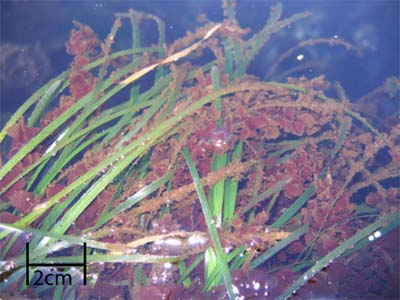
Surf Grass
Ecology
Tide pool at Botanical Beach on Vancouver Island, Canada
Tide pool with anemonies and surf grass. Photo taken at Botanical Beach on Vancouver Island, Canada Blade length - 45cm
|
|
Vast forests of surf grass provide habitat and protection for other organisms in low intertidal and sub-tidal environments. Ecosystem Services Dense forests of surf grass provide shelter for other organisms such as snails, fish and coralline algae. Smithora naiadum an epiphytic red alga and Melobesia an epiphytic encrusting alga commonly grow on blade tips of surf grass.
Smithora naiadum an epiphytic red alga growing on blade tip of surf grass. Botanical Beach tide pool on Vancouver Island, Canada. Surf grasses also filter water, trap sediments and increasing water clarity. Surf grasses are primary producers of vegetation in food webs and provide food for organism such as herbivores. Surf grasses rank amongst the most productive of marine primary producers (Duarte and Chiscano, 1999). Seagrass metabolism change the concentration of carbon and oxygen in water by sequestering carbon dioxide and respire oxygen. Vast forest of surf grass can modify the severity of water current, making near shore habitats relatively protected from big surf. The structure of seagrass canopy, modifies water current velocity and waves, enhancing sedimentation of suspended particles and prevent sediment resuspension (Garcia and Duarte, 2001).
References Duate CM and Chiscano CL (1999). Seagrass biomass and production: Areassesment. Aquat. Bot 65: 159- 174. Gacia E and Duate CM (2001). Sediment retention by a Mediterranean Posidonia oceanica meadow: The balance between deposition and resuspension. Est. Coast. Shelf. Sci. 52: 505 – 514. |


 Snail living in forest of Surf Grass. Tide pool at Botanical Beach on Vancouver Island, Canada
Snail living in forest of Surf Grass. Tide pool at Botanical Beach on Vancouver Island, Canada